Calcium-Based Sorbent Carbonation at Low Temperature via Reactive Milling under CO2
Abstract
1. Introduction
2. Experimental
2.1. Sorbent Preparation
2.1.1. CaO Preparation
2.1.2. Ca(OH)2 Preparation
2.2. Reactive Milling Carbonation
2.3. Temperature-Programmed Decarbonation
3. Results and Discussion
3.1. Sorbent Characterization
3.2. Sorbent Carbonation by Reactive Milling
3.3. Spent Sorbent Regeneration
4. Conclusions
Supplementary Materials
Author Contributions
Funding
Data Availability Statement
Conflicts of Interest
References
- Grasa, G.S.; Abanades, J.C. CO2 Capture Capacity of CaO in Long Series of Carbonation/Calcination Cycles. Ind. Eng. Chem. Res. 2006, 45, 8846–8851. [Google Scholar] [CrossRef]
- Ridha, F.N.; Wu, Y.; Manovic, V.; Macchi, A.; Anthony, E.J. Enhanced CO2 Capture by Biomass-Templated Ca(OH)2-Based Pellets. Chem. Eng. J. 2015, 274, 69–75. [Google Scholar] [CrossRef]
- Montes-Hernandez, G.; Chiriac, R.; Toche, F.; Renard, F. Gas–Solid Carbonation of Ca(OH)2 and CaO Particles under Non-Isothermal and Isothermal Conditions by Using a Thermogravimetric Analyzer: Implications for CO2 Capture. Int. J. Greenh. Gas Control. 2012, 11, 172–180. [Google Scholar] [CrossRef]
- Kim, S.; Jeon, J.; Kim, M.-J. Vaterite Production and Particle Size and Shape Control Using Seawater as an Indirect Carbonation Solvent. J. Environ. Chem. Eng. 2022, 10, 107296. [Google Scholar] [CrossRef]
- Criado, Y.A.; Arias, B.; Abanades, J.C. Effect of the Carbonation Temperature on the CO2 Carrying Capacity of CaO. Ind. Eng. Chem. Res. 2018, 57, 12595–12599. [Google Scholar] [CrossRef]
- Hanak, D.P.; Biliyok, C.; Anthony, E.J.; Manovic, V. Modelling and Comparison of Calcium Looping and Chemical Solvent Scrubbing Retrofits for CO2 Capture from Coal-Fired Power Plant. Int. J. Greenh. Gas Control. 2015, 42, 226–236. [Google Scholar] [CrossRef]
- Zhao, M.; Minett, A.I.; Harris, A.T. A Review of Techno-Economic Models for the Retrofitting of Conventional Pulverised-Coal Power Plants for Post-Combustion Capture (PCC) of CO2. Energy Environ. Sci. 2013, 6, 25–40. [Google Scholar] [CrossRef]
- Santos, M.P.S.; Manovic, V.; Hanak, D.P. Unlocking the Potential of Pulp and Paper Industry to Achieve Carbon-Negative Emissions via Calcium Looping Retrofit. J. Clean. Prod. 2021, 280, 124431. [Google Scholar] [CrossRef]
- Hassani, E.; Feyzbar-Khalkhali-Nejad, F.; Rashti, A.; Oh, T.-S. Carbonation, Regeneration, and Cycle Stability of the Mechanically Activated Ca(OH)2 Sorbents for CO2 Capture: An In Situ X-Ray Diffraction Study. Ind. Eng. Chem. Res. 2020, 59, 11402–11411. [Google Scholar] [CrossRef]
- Cazorla-Amoros, D.; Joly, J.P.; Linares-Solano, A.; Marcilla-Gomis, A.; Salinas-Martinez de Lecea, C. Carbon Dioxide-Calcium Oxide Surface and Bulk Reactions: Thermodynamic and Kinetic Approach. J. Phys. Chem. 1991, 95, 6611–6617. [Google Scholar] [CrossRef]
- Lu, H.; Khan, A.; Pratsinis, S.E.; Smirniotis, P.G. Flame-Made Durable Doped-CaO Nanosorbents for CO2 Capture. Energy Fuels 2009, 23, 1093–1100. [Google Scholar] [CrossRef]
- Wang, J.; Huang, L.; Yang, R.; Zhang, Z.; Wu, J.; Gao, Y.; Wang, Q.; O’Hare, D.; Zhong, Z. Recent Advances in Solid Sorbents for CO2 Capture and New Development Trends. Energy Environ. Sci. 2014, 7, 3478–3518. [Google Scholar] [CrossRef]
- Hu, Y.; Liu, W.; Chen, H.; Zhou, Z.; Wang, W.; Sun, J.; Yang, X.; Li, X.; Xu, M. Screening of Inert Solid Supports for CaO-Based Sorbents for High Temperature CO2 Capture. Fuel 2016, 181, 199–206. [Google Scholar] [CrossRef]
- Hassani, E.; Cho, J.; Feyzbar-Khalkhali-Nejad, F.; Rashti, A.; Jang, S.S.; Oh, T.-S. Ca2CuO3: A High Temperature CO2 Sorbent with Rapid Regeneration Kinetics. J. Environ. Chem. Eng. 2022, 10, 107334. [Google Scholar] [CrossRef]
- Hassani, E.; Feyzbar-Khalkhali-Nejad, F.; Rashti, A.; Oh, T.-S. Solid-State Decomposition of Ca2CuO3 Enhances Its CO2 Reactivity and Cycle Stability. Fuel 2023, 332, 126160. [Google Scholar] [CrossRef]
- Sayyah, M.; Ito, B.R.; Rostam-Abadi, M.; Lu, Y.; Suslick, K.S. CaO-Based Sorbents for CO2 Capture Prepared by Ultrasonic Spray Pyrolysis. RSC Adv. 2013, 3, 19872. [Google Scholar] [CrossRef]
- Zhao, C.; Zhou, Z.; Cheng, Z. Sol–Gel-Derived Synthetic CaO-Based CO2 Sorbents Incorporated with Different Inert Materials. Ind. Eng. Chem. Res. 2014, 53, 14065–14074. [Google Scholar] [CrossRef]
- Martavaltzi, C.S.; Lemonidou, A.A. Parametric Study of the CaO−Ca12Al14O33 Synthesis with Respect to High CO2 Sorption Capacity and Stability on Multicycle Operation. Ind. Eng. Chem. Res. 2008, 47, 9537–9543. [Google Scholar] [CrossRef]
- Li, Z.; Cai, N.; Huang, Y.; Han, H. Synthesis, Experimental Studies, and Analysis of a New Calcium-Based Carbon Dioxide Absorbent. Energy Fuels 2005, 19, 1447–1452. [Google Scholar] [CrossRef]
- Yoon, H.J.; Lee, K.B. Introduction of Chemically Bonded Zirconium Oxide in CaO-Based High-Temperature CO2 Sorbents for Enhanced Cyclic Sorption. Chem. Eng. J. 2019, 355, 850–857. [Google Scholar] [CrossRef]
- Sultana, K.S.; Tran, D.T.; Walmsley, J.C.; Rønning, M.; Chen, D. CaO Nanoparticles Coated by ZrO2 Layers for Enhanced CO2 Capture Stability. Ind. Eng. Chem. Res. 2015, 54, 8929–8939. [Google Scholar] [CrossRef]
- Ping, H.; Wu, S. CO2 Sorption Durability of Zr-Modified Nano-CaO Sorbents with Cage-like Hollow Sphere Structure. ACS Sustain. Chem. Eng. 2016, 4, 2047–2055. [Google Scholar] [CrossRef]
- Naeem, M.A.; Armutlulu, A.; Imtiaz, Q.; Donat, F.; Schäublin, R.; Kierzkowska, A.; Müller, C.R. Optimization of the Structural Characteristics of CaO and Its Effective Stabilization Yield High-Capacity CO2 Sorbents. Nat. Commun. 2018, 9, 2408. [Google Scholar] [CrossRef]
- Ramirez-Solis, S.; Dupont, V.; Milne, S.J. Preparation and Evaluation of CaO-Based CO2 Sorbents Deposited on Saffil Fiber Supports. Energy Fuels 2018, 32, 8631–8640. [Google Scholar] [CrossRef]
- Alshafei, F.H.; Minardi, L.T.; Rosales, D.; Chen, G.; Simonetti, D.A. Improved Sorption-Enhanced Steam Methane Reforming via Calcium Oxide–Based Sorbents with Targeted Morphology. Energy Technol. 2019, 7, 1800807. [Google Scholar] [CrossRef]
- Liu, F.-Q.; Li, W.-H.; Liu, B.-C.; Li, R.-X. Synthesis, Characterization, and High Temperature CO2 Capture of New CaO Based Hollow Sphere Sorbents. J. Mater. Chem. A 2013, 1, 8037. [Google Scholar] [CrossRef]
- Broda, M.; Müller, C.R. Synthesis of Highly Efficient, Ca-Based, Al2O3-Stabilized, Carbon Gel-Templated CO2 Sorbents. Adv. Mater. 2012, 24, 3059–3064. [Google Scholar] [CrossRef]
- Ma, X.; Li, Y.; Yan, X.; Zhang, W.; Zhao, J.; Wang, Z. Preparation of a Morph-Genetic CaO-Based Sorbent Using Paper Fibre as a Biotemplate for Enhanced CO2 Capture. Chem. Eng. J. 2019, 361, 235–244. [Google Scholar] [CrossRef]
- Wei, S.; Han, R.; Su, Y.; Gao, J.; Zhao, G.; Qin, Y. Pore Structure Modified CaO-Based Sorbents with Different Sized Templates for CO2 Capture. Energy Fuels 2019, 33, 5398–5407. [Google Scholar] [CrossRef]
- Soong, Y.; Fauth, D.L.; Howard, B.H.; Jones, J.R.; Harrison, D.K.; Goodman, A.L.; Gray, M.L.; Frommell, E.A. CO2 Sequestration with Brine Solution and Fly Ashes. Energy Convers. Manag. 2006, 47, 1676–1685. [Google Scholar] [CrossRef]
- Montes-Hernandez, G.; Pérez-López, R.; Renard, F.; Nieto, J.M.; Charlet, L. Mineral Sequestration of CO2 by Aqueous Carbonation of Coal Combustion Fly-Ash. J. Hazard. Mater. 2009, 161, 1347–1354. [Google Scholar] [CrossRef] [PubMed]
- Gerdemann, S.J.; O’Connor, W.K.; Dahlin, D.C.; Penner, L.R.; Rush, H. Ex Situ Aqueous Mineral Carbonation. Environ. Sci. Technol. 2007, 41, 2587–2593. [Google Scholar] [CrossRef] [PubMed]
- Porcheddu, A.; Cincotti, A.; Delogu, F. Kinetics of MgH2 Formation by Ball Milling. Int. J. Hydrog. Energy 2021, 46, 967–973. [Google Scholar] [CrossRef]
- Vyazovkin, S.; Burnham, A.K.; Criado, J.M.; Pérez-Maqueda, L.A.; Popescu, C.; Sbirrazzuoli, N. ICTAC Kinetics Committee Recommendations for Performing Kinetic Computations on Thermal Analysis Data. Thermochim. Acta 2011, 520, 1–19. [Google Scholar] [CrossRef]
- Fedunik-Hofman, L.; Bayon, A.; Hinkley, J.; Lipiński, W.; Donne, S.W. Friedman Method Kinetic Analysis of CaO-Based Sorbent for High-Temperature Thermochemical Energy Storage. Chem. Eng. Sci. 2019, 200, 236–247. [Google Scholar] [CrossRef]
- Hung, K.-C.; Yeh, H.; Yang, T.-C.; Wu, T.-L.; Xu, J.-W.; Wu, J.-H. Characterization of Wood-Plastic Composites Made with Different Lignocellulosic Materials That Vary in Their Morphology, Chemical Composition and Thermal Stability. Polymers 2017, 9, 726. [Google Scholar] [CrossRef] [PubMed]
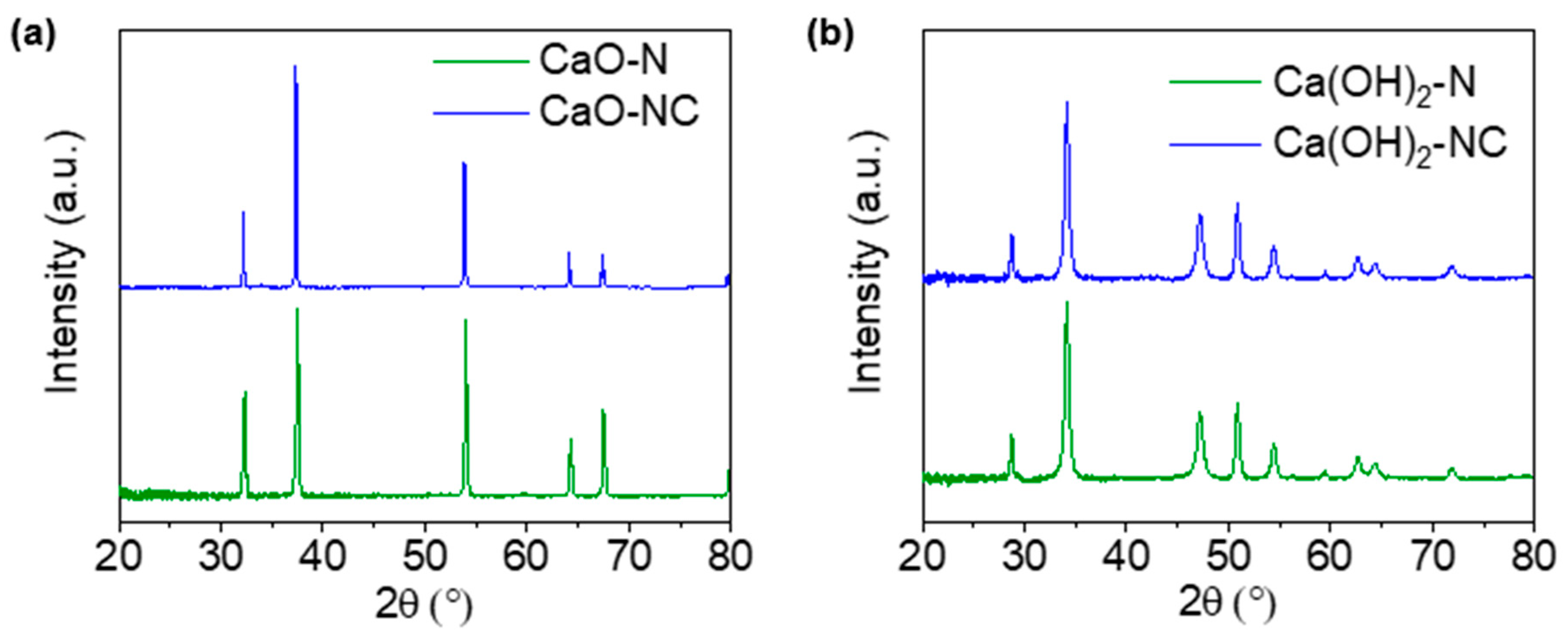


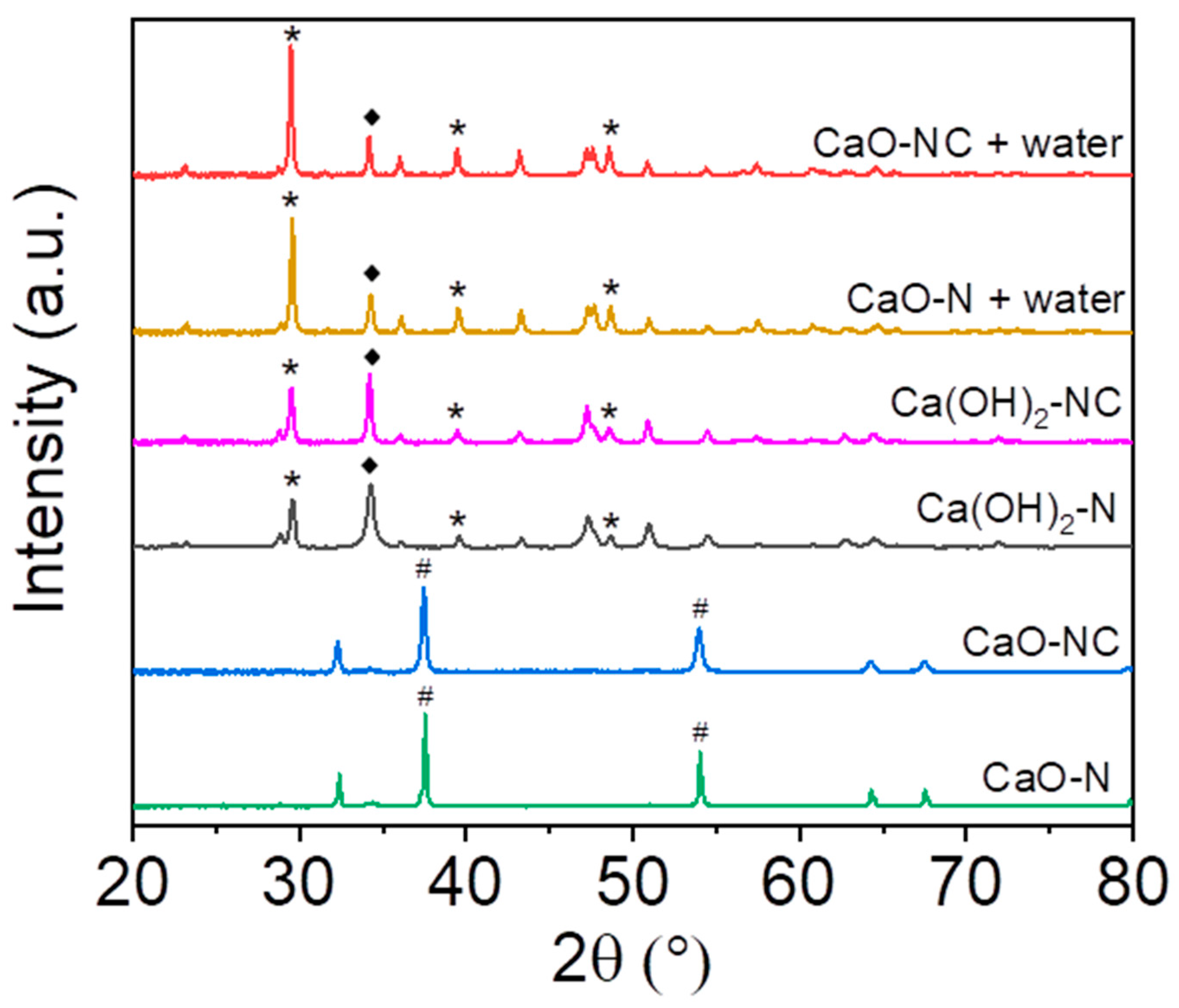
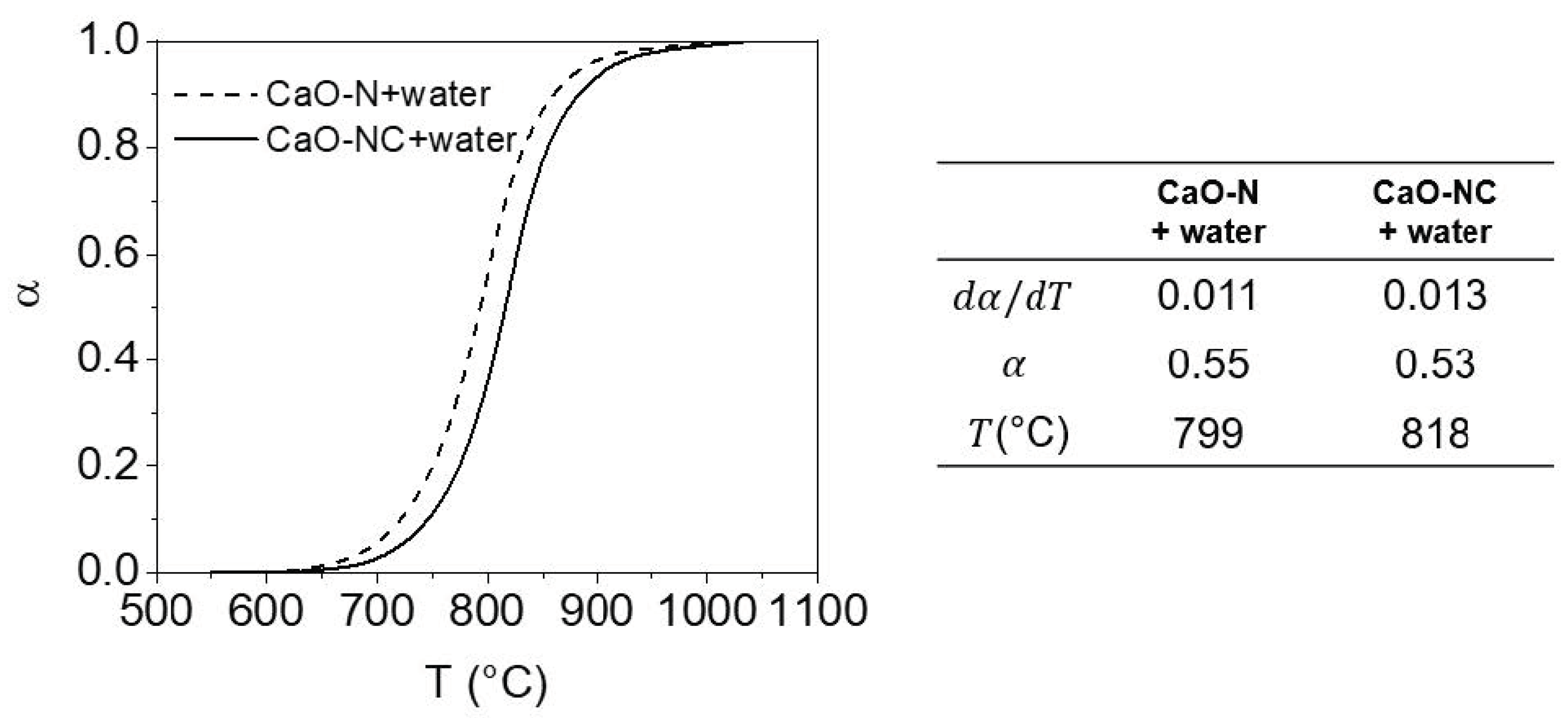
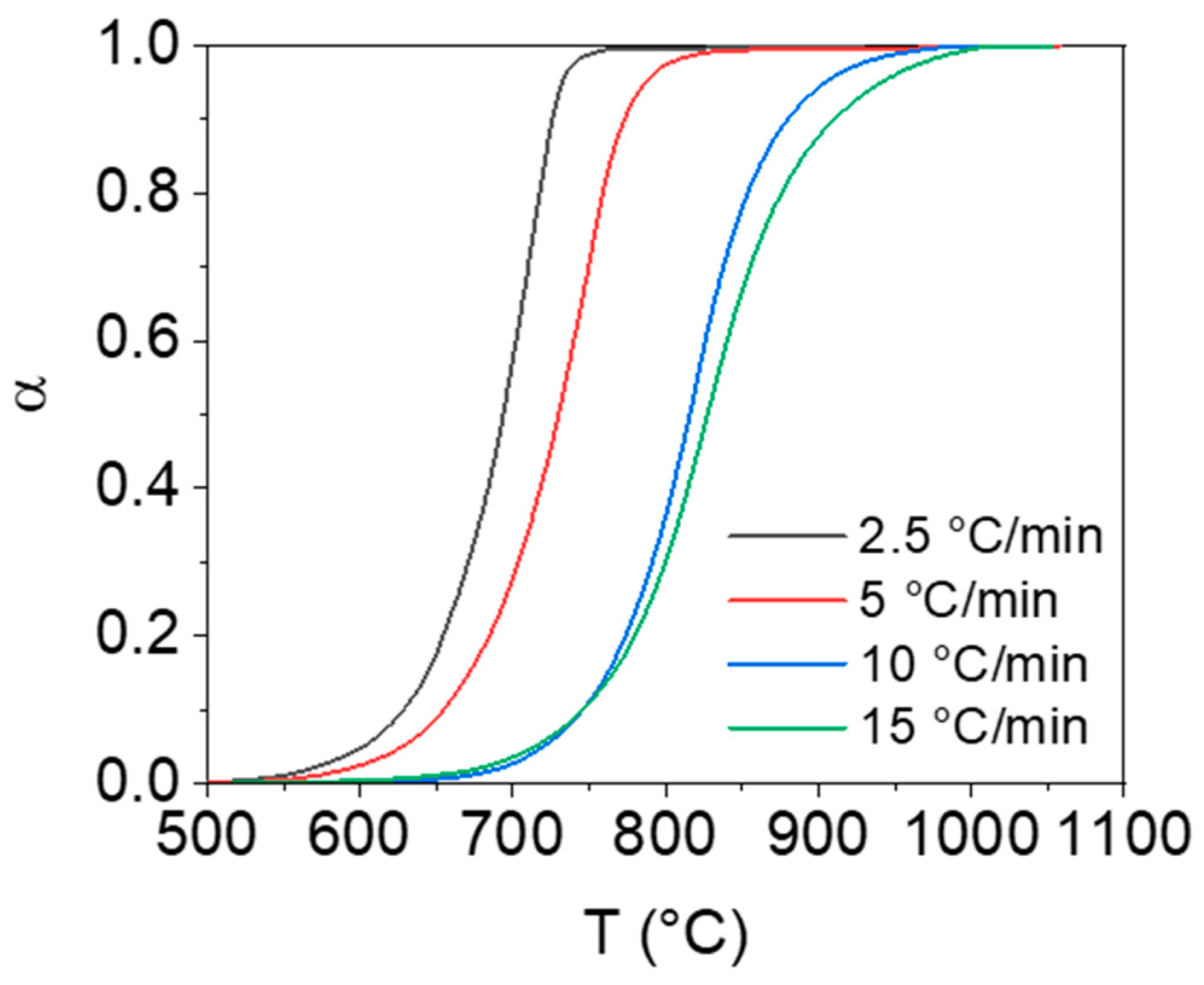
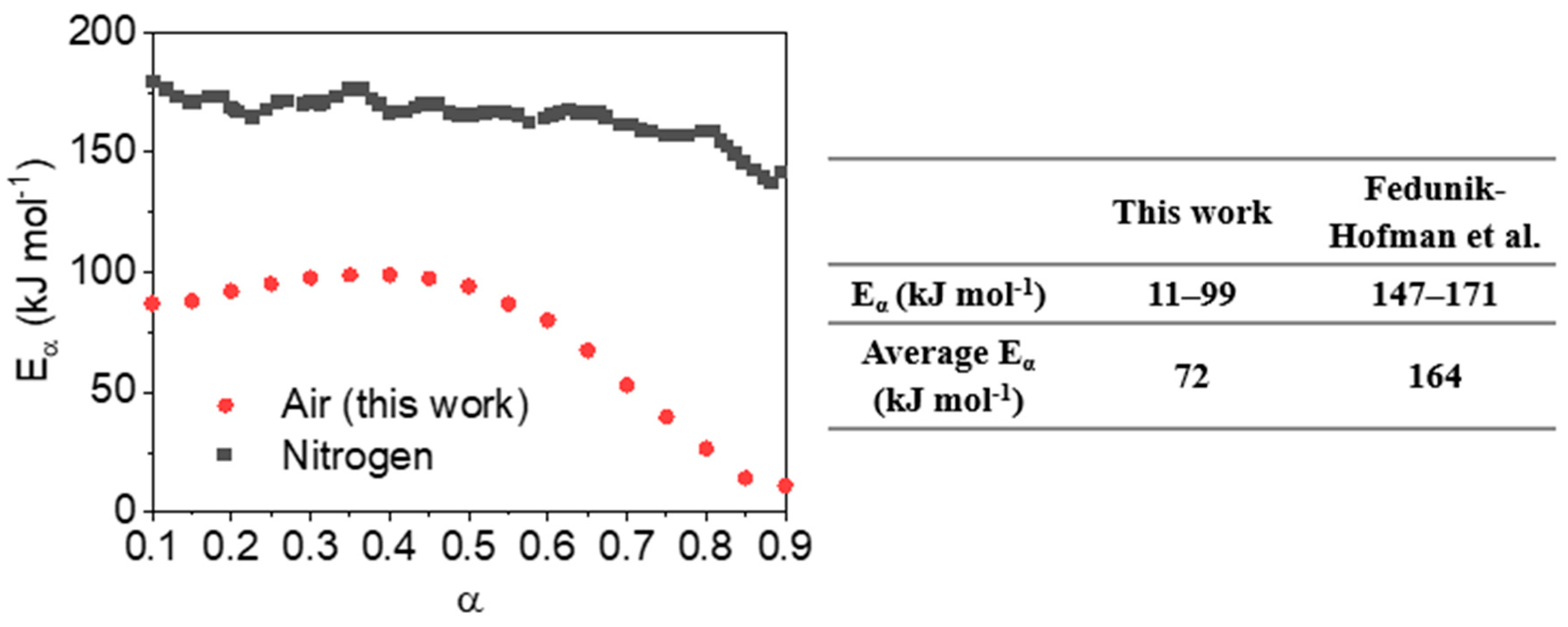
| Sorbent Name | BET Surface Area (m2/g) | Total Pore Volume (cm3/g) | Average Pore Diameter (nm) |
|---|---|---|---|
| CaO-N | 14.7 | 0.015 | 4.20 |
| Ca(OH)2-N | 29.1 | 0.149 | 10.3 |
| CaO-NC | 50.9 | 0.099 | 7.76 |
| Ca(OH)2-NC | 34.1 | 0.135 | 7.9 |
| Heating Rate (°C/min) | 2.5 | 5 | 10 | 15 |
|---|---|---|---|---|
| Air (this work) | 0.033 | 0.016 | 0.013 | 0.0084 |
| Nitrogen [35] | 0.023 | 0.015 | 0.011 | 0.0086 |
Disclaimer/Publisher’s Note: The statements, opinions and data contained in all publications are solely those of the individual author(s) and contributor(s) and not of MDPI and/or the editor(s). MDPI and/or the editor(s) disclaim responsibility for any injury to people or property resulting from any ideas, methods, instructions or products referred to in the content. |
© 2023 by the authors. Licensee MDPI, Basel, Switzerland. This article is an open access article distributed under the terms and conditions of the Creative Commons Attribution (CC BY) license (https://creativecommons.org/licenses/by/4.0/).
Share and Cite
Taghavi Kouzehkanan, S.M.; Hassani, E.; Feyzbar-Khalkhali-Nejad, F.; Oh, T.-S. Calcium-Based Sorbent Carbonation at Low Temperature via Reactive Milling under CO2. Inorganics 2023, 11, 200. https://doi.org/10.3390/inorganics11050200
Taghavi Kouzehkanan SM, Hassani E, Feyzbar-Khalkhali-Nejad F, Oh T-S. Calcium-Based Sorbent Carbonation at Low Temperature via Reactive Milling under CO2. Inorganics. 2023; 11(5):200. https://doi.org/10.3390/inorganics11050200
Chicago/Turabian StyleTaghavi Kouzehkanan, Seyed Morteza, Ehsan Hassani, Farshad Feyzbar-Khalkhali-Nejad, and Tae-Sik Oh. 2023. "Calcium-Based Sorbent Carbonation at Low Temperature via Reactive Milling under CO2" Inorganics 11, no. 5: 200. https://doi.org/10.3390/inorganics11050200
APA StyleTaghavi Kouzehkanan, S. M., Hassani, E., Feyzbar-Khalkhali-Nejad, F., & Oh, T.-S. (2023). Calcium-Based Sorbent Carbonation at Low Temperature via Reactive Milling under CO2. Inorganics, 11(5), 200. https://doi.org/10.3390/inorganics11050200






